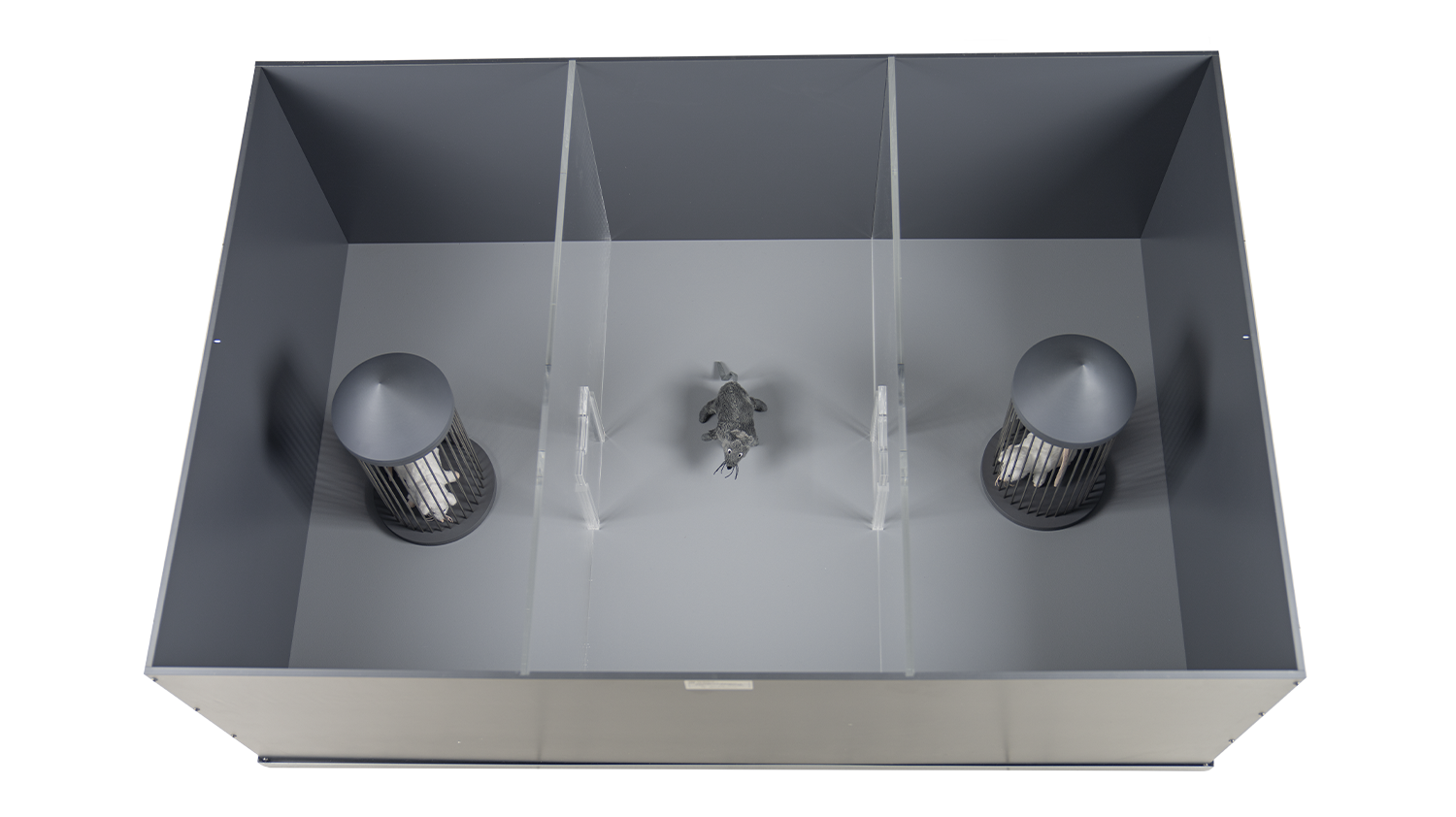Dysfunction in social behavior and social recognition are characteristic of many neuropsychiatric disorders, such as schizophrenia or bipolar disorders, and a prominent symptom of neurodevelopmental disorders, such as autism.
Research has shown that, although human social behavior is generally more complex, humans and animals share some aspects of social behavior.
Rodents normally prefer to spend time with another rodent (sociability) and will investigate a novel intruder more than a familiar one (social novelty). The three-chambered test is a valuable tool to assess general sociability and interest in social novelty in rodent models with CNS disorders.
The three-chamber test is the classic test to assess social behavior and social memory in rodents. This may range from autism disease to dominance tests and social novelty. Additional applications include sociability differences between genders, strains and any other variable, which may end up with a social preference.
GTF2I dosage regulates neuronal differentiation and social behavior in 7q11.23 neurodevelopmental disorders
Ugo Basile three-chamber sociability apparatus ha been recently cited in the open access research article “GTF2I dosage regulates neuronal differentiation and social behavior in 7q11.23 neurodevelopmental disorders”.
The research delves deep into the mechanisms underlying conditions such as Williams syndrome (WS) and 7q11.23 duplication syndrome (Dup7). Led by a team of scientists, this study promises significant insights into understanding and potentially addressing these complex disorders.
The 7q11.23 region harbors the GTF2I gene, implicated in both WS and Dup7. Individuals with WS exhibit hypersociability, characterized by an affinity for social interaction, while those with Dup7 often display social impairments. However, the molecular mechanisms governing these divergent social behaviors have remained elusive until now.
The study employs a multifaceted approach, combining molecular biology techniques, neural differentiation assays, and behavioral analyses in mouse models. By manipulating GTF2I dosage levels, researchers elucidate its role in neuronal development and social behavior. Remarkably, altering GTF2I expression levels influences the differentiation of neural progenitor cells, impacting neuronal morphology and synaptic connectivity.
Moreover, the research uncovers a direct correlation between GTF2I dosage and sociability in mice. Mice with reduced GTF2I levels exhibit decreased sociability, mimicking the social deficits observed in Dup7, whereas elevated GTF2I levels enhance sociability akin to WS traits. These findings underscore the pivotal role of GTF2I in modulating social behavior, offering a compelling link between genetic predisposition and behavioral phenotypes in neurodevelopmental disorders.
Furthermore, the study implicates GTF2I in the regulation of key signaling pathways involved in synaptic plasticity and neuronal connectivity. Dysregulation of these pathways may underlie the aberrant social behaviors observed in WS and Dup7. Thus, targeting GTF2I and its downstream effectors could hold therapeutic potential for ameliorating social deficits in these disorders.
In summary, the research on GTF2I dosage highlights its critical role in neuronal differentiation and social behavior, providing valuable insights into the pathophysiology of neurodevelopmental disorders. By unraveling the intricate molecular mechanisms governing social behavior, this study opens new avenues for therapeutic interventions and personalized treatments for individuals affected by WS, Dup7, and related conditions.
Behavioural experiment with Ugo Basile three-chamber sociability apparatus
In elucidating the complex interplay between genetics and social behavior, researchers often rely on sophisticated behavioral assays to dissect the underlying mechanisms. One such tool, the three-chamber sociability test developed by Ugo Basile, emerges as a cornerstone in studying sociability in preclinical models.
This behavioral test provides a robust framework for assessing social interactions and preferences in rodents, offering valuable insights into the neurobiological basis of social behavior. The apparatus consists of three interconnected chambers, allowing for the simultaneous evaluation of sociability, social novelty preference, and general exploratory behavior.
After a period of habituation, the test subject is placed in the central chamber, with two adjoining chambers containing either an empty enclosure or a conspecific (social stimulus). The subject sociability is determined by measuring the time spent by the freely-moving subject in the proximity of the grid enclosures containing the first unfamiliar (stranger) mouse or rat. A second stranger is then introduced in the box within its enclosure and the preference for the new mouse/rat can be easily assessed.
Crucially, the three-chamber sociability test enables researchers to distinguish between sociability and preference for social novelty. By introducing a novel social stimulus in one of the chambers during the subsequent phase, investigators can assess the subject's propensity for social exploration versus social novelty preference.
The versatility of this paradigm extends to various experimental manipulations, including genetic modifications, pharmacological interventions, and environmental manipulations. Researchers leverage this flexibility to elucidate the neural circuits, neurotransmitter systems, and genetic factors underlying social behavior and its dysregulation in neurodevelopmental disorders.
In the context of the study on GTF2I dosage and social behavior, the three-chamber sociability test serves as a fundamental tool for assessing sociability in mouse models. By subjecting mice with altered GTF2I expression levels to this paradigm, researchers can quantitatively evaluate the impact of GTF2I dosage on social interactions and preferences.
Overall, the three-chamber sociability test by Ugo Basile represents a cornerstone in behavioral neuroscience, facilitating the comprehensive investigation of social behavior in preclinical models. Its application in the study of neurodevelopmental disorders underscores its significance in unraveling the intricate mechanisms governing social behavior and fostering translational research aimed at developing targeted interventions for these conditions.
Want to replicate the bahavioural experiment with three-chambre sociability apparatus? https://www.science.org/doi/10.1126/sciadv.adh2726#sec-3
Ugo Basile three-chamber sociability test

After a period of habituation, the subject sociability is determined by measuring the time spent by the freely-moving subject in the proximity of the grid enclosures containing the first unfamiliar (stranger) mouse or rat. A second stranger is then introduced in the box within its enclosure and the preference for the new mouse/rat can be easily assessed. The Ugo Basile system comes complete with:
-
High contrast or IR-transparent removable floor for the best quality video-tracking.
-
A three-compartment chamber with removable doors.
-
Inner and external walls can be transparent or not.
-
Internal partitions can be easily removed for cleaning.
-
Circular bar grid enclosures for the non-moving animals maximize animal interaction and have different heights and shapes to avoid animal climbing on the enclosure top (the rat version is cone-shaped)
Ugo Basile apparatus come in different colors and is available in different models, both for rats and for mice.
The system can be completed with video-tracking software, IR-sensitive camera, vari-focal lens objective and ceiling mount. Multiple cages can be tracked simultaneously.
Learn more about Ugo Basile three-chamber sociability apparatus: https://ugobasile.com/products/categories/mazes-tracking/sociability-apparatus-for-mice-and-rats-3-chambered-social-test

